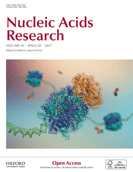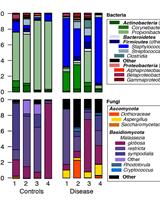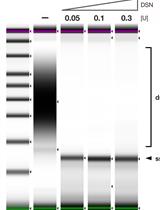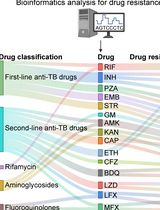- EN - English
- CN - 中文
ChIP-seq Experiment and Data Analysis in the Cyanobacterium Synechocystis sp. PCC 6803
蓝藻集胞藻PCC 6803的ChIP-seq实验和数据分析
发布: 2018年06月20日第8卷第12期 DOI: 10.21769/BioProtoc.2895 浏览次数: 13172
评审: Modesto Redrejo-RodriguezAnonymous reviewer(s)
Abstract
Nitrogen is an essential nutrient for all living organisms. In cyanobacteria, a group of oxygenic photosynthetic bacteria, nitrogen homeostasis is maintained by an intricate regulatory network around the transcription factor NtcA. Although mechanisms controlling NtcA activity appear to be well understood, the sets of genes under its control (i.e., its regulon) remain poorly defined. In this protocol, we describe the procedure for chromatin immunoprecipitation using NtcA antibodies, followed by DNA sequencing analysis (ChIP-seq) during early acclimation to nitrogen starvation in the cyanobacterium Synechocystis sp. PCC 6803 (hereafter Synechocystis). This protocol can be extended to analyze any DNA-binding protein in cyanobacteria for which suitable antibodies exist.
Keywords: ChIP-seq (ChIP-seq)Background
To maintain homeostasis, bacteria frequently need to adjust gene expression in response to environmental changes. Many of these adjustments are controlled by transcriptional factors (TF) that sense metabolic signals and activate or repress target genes. However, reflecting the traditionally laborious tasks necessary to characterize the activity and scope of TFs in vivo, our knowledge of their binding sites in bacteria is still limited. Only recently, the combination of chromatin immunoprecipitation with high-throughput sequencing analysis has opened the door to rapid determination of genome-level regulons. In particular, ChIP-seq uses the capacity of next-generation sequencing (NGS) to identify numerous DNA sequences in parallel. An attractive feature of ChIP-seq, compared to microarrays, is that there is no restriction to certain regions, such as promoter sequences, and the whole genome can be investigated for TF binding sites.
In cyanobacteria, the global regulator for nitrogen assimilation and metabolism is NtcA, a TF belonging to the CRP (cAMP receptor protein) family (Herrero et al., 2001). In Synechocystis, NtcA controls the cellular response to nitrogen availability by binding as a dimer to the promotor or intragenic regions of its target genes containing the consensus sequence GTAN8TAC (Herrero et al., 2001; Giner-Lamia et al., 2017). In the absence of ammonium, NtcA activates the expression of genes for nitrogen assimilation pathways but also acts as a transcriptional repressor of other genes, such as gifA and gifB, which encode for the glutamine synthetase inactivating factors IF7 and IF17 (García-Domínguez et al., 2000).
The protocol detailed herein has been optimized for immunoprecipitation of DNA from Synechocystis cells using antibodies against NtcA, followed by NGS to identify the specific binding sites of NtcA during early acclimation to nitrogen depletion. Following this protocol, we identified 192 genomic regions bound by NtcA (51 in ammonium-replete conditions and 141 after 4 h of nitrogen starvation) (Giner-Lamia et al., 2017). This protocol can be extended to study other TFs in cyanobacteria. Although the bioinformatic component is applicable to any sequenced prokaryote, the wet-lab component needs to be optimized to ensure efficient DNA extraction.
Materials and Reagents
- 2 ml screw-cap conical tubes (Thermo Fisher Scientific, catalog number: 3462 )
- Glass beads, acids-washed 425-600 µm (Sigma-Aldrich, catalog number: G8772-10G )
- 0.5 ml PCR tubes (Eppendorf, catalog number: 0030124537 )
- 1.5 ml tubes (Eppendorf, catalog number: 022363204 )
- 15 and 50 ml FalconTM tubes (Corning, catalog numbers: 352070 )
- DynaMagTM-2 Magnet (Thermo Fisher Scientific, catalog number: 12321D )
- Synechocystis sp. PCC 6803 cells grown on a plate of BG110C-agar (Stanier et al., 1971)
- NH4Cl (Sigma-Aldrich, catalog number: 254134 )
- TES (Sigma-Aldrich, catalog number: T1375 )
- 37% Formaldehyde (Sigma-Aldrich, catalog number: F8775 )
- Glycine (Sigma-Aldrich, catalog number: 50046 )
- NaCl (Sigma-Aldrich, catalog number: S7653-250G )
- EDTA (Sigma-Aldrich, catalog number: E9884 )
- Agarose (NZYTech, catalog number: MB02702 )
- Triton X-100 (Sigma-Aldrich, catalog number: T8787 )
- Sodium deoxycholate (Sigma-Aldrich, catalog number: 30970 )
- Protease inhibitor cocktail tablets SIGMAFAST (Sigma-Aldrich, catalog number: S8820-2TAB )
- NP-40 (Sigma-Aldrich, catalog number: 74385 )
- LiCl (Sigma-Aldrich, catalog number: L9650 )
- Anti-NtcA antibody (Giner-Lamia et al., 2017)
- SDS (Sigma-Aldrich, catalog number: L3771 )
- BSA (Sigma-Aldrich, catalog number: B4287 )
- DNase-free RNase A solution (Thermo Fisher Scientific, catalog number: EN0531 )
- Proteinase K (Thermo Fisher Scientific, catalog number: 25530049 )
- Phenol:Chloroform:Isoamyl alcohol (25:24:1) (Sigma-Aldrich, catalog number: P2069 )
- CaCl2 (Sigma-Aldrich, catalog number: 449709 )
- Glycerol (Sigma-Aldrich, catalog number: G5516 )
- MnCl2·4H2O (Sigma-Aldrich, catalog number: 221279 )
- ZnSO4·7H2O (Sigma-Aldrich, catalog number: Z1001 )
- Na2MoO4·2H2O (Sigma-Aldrich, catalog number: 331058 )
- CuSO4 (PubChem, catalog number: 24462 )
- Co(NO3)2·6H2O (Sigma-Aldrich, catalog number: 239267 )
- MgSO4·7H2O (Sigma-Aldrich, catalog number: 63138 )
- CaCl2·2H2O (Sigma-Aldrich, catalog number: 223506 )
- Citric acid (Sigma-Aldrich, catalog number: 251275 )
- Na2-EDTA (Sigma-Aldrich, catalog number: 27285 )
- Na2CO3 (Sigma-Aldrich, catalog number: S1641 )
- Fe-NH4 citrate (Sigma-Aldrich, catalog number: F5879 )
- Boric acid, H3BO3 (Sigma-Aldrich, catalog number: B6768 )
- 100% freezer-cold ethanol
- MiniElute PCR purification kit (QIAGEN, catalog number: 28004 )
- dsDNA assay kit (Thermo Fisher Scientific, catalog number: Q32851 )
- SsoFastTM EvaGreen® Supermix (Bio-Rad Laboratories, catalog number: 172-5200 )
- PearceTM Protein G Magnetic Beads (Thermo Fisher Scientific, catalog number: 88847 )
- Bradford Protein Assay (Bio-Rad Laboratories, catalog number: 5000001 )
- 5x Tris-buffered saline (TBS) buffer (see Recipes)
- Lysis buffer (see Recipes)
- Block solution (see Recipes)
- Wash buffer 1 (see Recipes)
- Wash buffer 2 (see Recipes)
- 5x IP solution (see Recipes)
- Tris-EDTA (TE) + NaCl Solution (see Recipes)
- Proteinase K solution (see Recipes)
- Trace metal mix A5 (see Recipes)
- Autoclaved BG110C medium liquid (see Recipes) (Stanier et al., 1971)
- Autoclaved BG110C+NH4 medium liquid (see Recipes) (Stanier et al., 1971)
Equipment
- Micropipettes (1,000, 100, 20 and 10 µl)
- 2 L flask and 2 x 1 L flask
- Orbital Shaker (VWR, model: 3600 )
- FastPrep-24 instrument (MP Biomedicals, catalog number: 116004500 )
- Eppendorf Thermomixer R Mixer, 1.5 ml Block (Eppendorf, model: ThermoMixer® R , catalog number: 5355)
- Eppendorf MiniSpin plus® (Eppendorf, model: MiniSpin plus® )
- Eppendorf centrifuge Falcon (Eppendorf, model: 5810R )
- MyCyclerTM Thermal Cycler System (Bio-Rad Laboratories, catalog number: 1709703 )
- Sonicator ultrasonic Processor XL (QSonica, model: XL-2020 )
- Quibit® 2.0 Fluorometer (Thermo Fisher Scientific, model: Quibit® 2.0 )
- CFX Connect Real-Time PCR Detection System (Bio-Rad Laboratories, catalog number: 1855201 )
- HiSeqTM 2000 Sequencing System (Illumina)
- Personal computer with a minimum of 2 GB of RAM and 2 GHz dual-core processor, a minimum of 25-50 GB of hard-drive space
Software
- FastQC (v0.11.5)
(https://www.bioinformatics.babraham.ac.uk/projects/fastqc/) - Bowtie2 (v2.3.4.1)
(http://bowtie-bio.sourceforge.net/bowtie2/index.shtml [Langmead and Salzberg, 2012]) - Samtools (v1.7)
(http://samtools.sourceforge.net [Li et al., 2009]) - DeepTools (v2.0)
(http://deeptools.readthedocs.io/en/latest/content/changelog.html [Ramírez et al., 2016]) - Model-based Analysis of ChIP-Seq (MACS) (v1.4.1)
http://liulab.dfci.harvard.edu/MACS/ [Zhang et al., 2008]) - BayesPeak (v1.22.0)
(http://bioconductor.org/packages/release/bioc/html/BayesPeak.html [Spyrou et al., 2009]) - Integrative Genomics Viewer (IGV) (v2.3)
(http://software.broadinstitute.org/software/igv/ [Robinson et al., 2011]) - ChIPseeker (v1.6.7)
(https://bioconductor.org/packages/release/bioc/html/ChIPseeker.html [Yu et al., 2015])
Procedure
文章信息
版权信息
© 2018 The Authors; exclusive licensee Bio-protocol LLC.
如何引用
Giner-Lamia, J., Hernández-Prieto, M. A. and Futschik, M. E. (2018). ChIP-seq Experiment and Data Analysis in the Cyanobacterium Synechocystis sp. PCC 6803. Bio-protocol 8(12): e2895. DOI: 10.21769/BioProtoc.2895.
分类
微生物学 > 微生物遗传学 > DNA > DNA 测序
分子生物学 > DNA > DNA-蛋白质相互作用
您对这篇实验方法有问题吗?
在此处发布您的问题,我们将邀请本文作者来回答。同时,我们会将您的问题发布到Bio-protocol Exchange,以便寻求社区成员的帮助。
Share
Bluesky
X
Copy link















